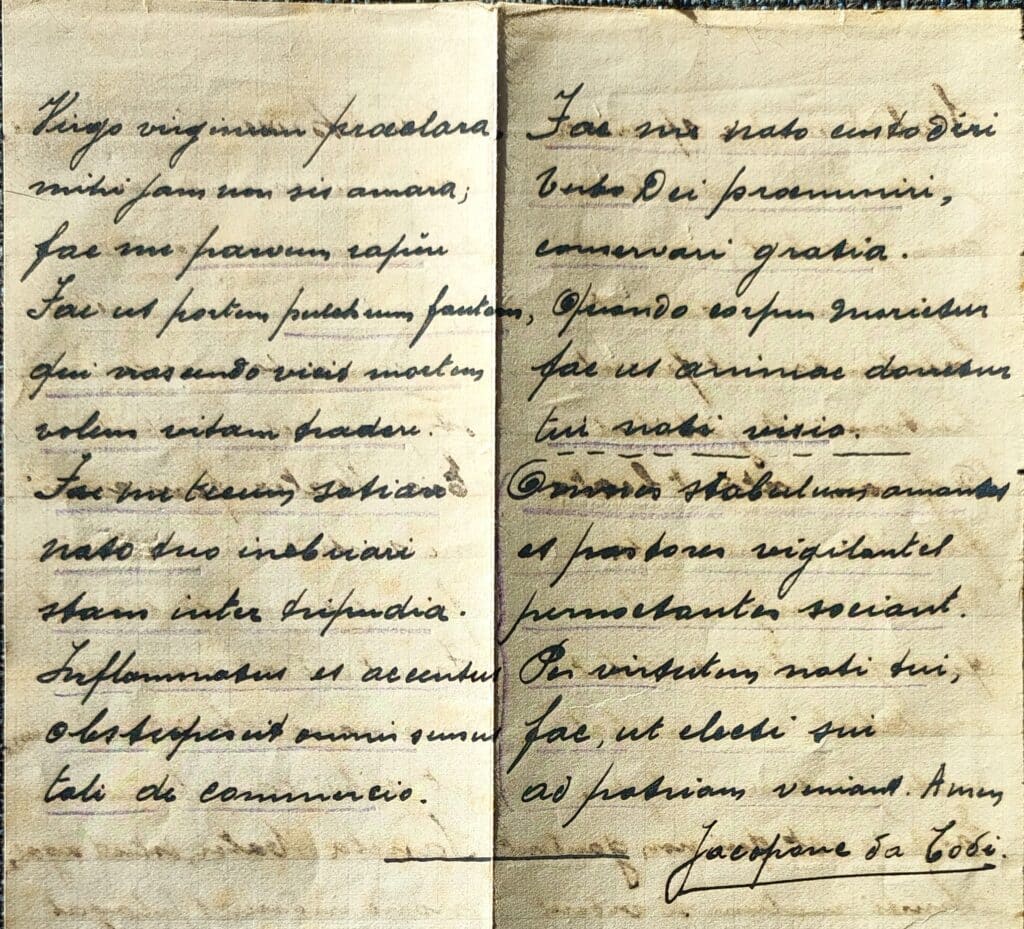
There is no better moment to write about the Stabat Mater Speciosa than around Christmas: about a joyful Mary, elated at the birth of her child. Where the Stabat Mater Dolorosa focuses on Mary’s grief at the crucifixion, the Speciosa version celebrates the joy and wonder of the Nativity. It explores in simple wording Mary’s maternal emotions, the miracle of Christ’s birth, and the divine mystery of the Incarnation.
The reason for this article is a message from Mr. Bart Janssen, who is active in the library of the Premonstratensian Abbey Postel, Belgium. He sent a photo of a note that had been found in the old and extensive library with the Latin text of the Stabat Mater Speciosa. The text of Postel contains two more stanzas than the version on our website (Latin and English translation) and stanza 14 is missing.
Extra stanzas in the version of the Postel Abbey:
| Omnes stabuluns amantes et pastores vigilantes pernoctantes sociant | Let all loving the stable and the shepherds, keeping watch through the night, gather together. |
| Per virtutem Nati tui fac ut electi sui ad patriam veniant. Amen | Through the virtue of your Born, make it so that your chosen ones may come to their homeland. Amen |
The title means ‘The Beautiful Mother Was Standing’ and it paints a tender, moving picture. It captures a moment every parent can relate to: a mother gazing at her newborn child with overwhelming love and wonder. We often see Mary depicted in art as solemn and distant, but here she’s portrayed as any new mother – filled with delight, unable to take her eyes off her baby.

Written – probably – by Jacopone da Todi in the 13th century, this Latin hymn is deeply rooted in medieval Christian devotional poetry and seeks to explore the spiritual and emotional dimensions of biblical events. In simple words the text explains the divine nature of Christ’s birth and the humility of the Nativity.
The Speciosa was almost forgotten until Antoine-Frédéric Ozanam (1813-1853) rescued the hymn when he transcribed it from a fifteenth-century manuscript and published it in 1852. The hymn follows the similar pattern to the Stabat Mater Dolorosa, with stanzas that are written in the same rhythmic style but it is easily seen that the rhyming scheme is not followed as strictly as in the “Dolorosa”, especially in the third lines (see stanzas 7 and 8: subditum – diversorio).. The text’s language is full of musicality and the repetitive structure helps to memorize and contemplate. There is another similarity between both Stabat Maters: in the second part, there is a passionate expression of wanting to share in Mary’s feelings: Dolorosa – deep sorrow, Speciosa – exuberant joy.
On our Ultimate Stabat Mater Website we already paid attention to Speciosa – compositions of Liszt, Van Baest, Thommesen and Monney. Last year we discovered more Speciosa-compositions, recently composed!
While the Stabat Mater Speciosa isn’t as much known or set to music as its counterpart Dolorosa, its message, in our often-troubled world, reminds us that even in the grandest of religious narratives, there are intimate moments of pure happiness. Whether you’re religious or not, there’s something universal about a mother’s joy that transcends time and culture.




